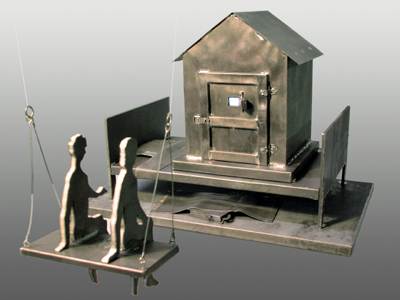______________________________________________________________________________
 video
video
VENERE
2007
Scultura digitale: Gli avatar di Botticelli
L’aspetto che piu’ mi affascina del progetto di scultura virtuale è la possibilità di giungere ad un oggetto fisico, tangibile, con un peso e una forma, partendo e passando esclusivamente attraverso gli algoritmi matematici di un software, coagulando polvere di nylon. E’ singolare che la polvere creatrice che ci accompagna da qualche millennio sia utilizzata anche dall’universo tecnologico per creare da nulla. Le figure sono realizzate a prescindere da una condizione fisica iniziale, senza creta, marmo, bronzo. Solamente uno schermo. In fondo un foglio di carta. Ma non un foglio rinascimentale leonardesco che registra degli oggetti emersi dalla “potenza di calcolo” del cervello di Leonardo, oggetti che vengono visualizzati, comunicati, attraverso un disegno il quale per essere compreso richiede il percorso alla rovescia, un ritorno alla creazione iniziale dell’artista per ricostruire con il nostro pensiero i movimenti di ingranaggi e leve da lui immaginati. Un dialogo a distanza. L’area di lavoro in questo caso è un foglio che già contiene le regole della corretta riproduzione della natura: è possibile muovere, ruotare e visualizzare in qualunque posizione un corpo e questo viene immediatamente ricreato e visualizzato senza un personale intervento di sapere grafico e anatomico. Il sapere è contenuto nel software, nel DNA digitale del programma che disegna e opera. L’interazione progettuale è slegata dalla conoscenza anatomica, dei materiali. Senza l’esperienza bravo fonditore, del ceramista che cuoce la creta, del fabbro che lavora il ferro. Tutti questi saperi non servono più e il processo di creazione inizia da un’idea proposta a e da una macchina, il computer, e termina con un oggetto, per ora inanimato e di plastica prodotto da un altro sistema digitale che assume il ruolo di scultore. All’artista il ruolo demiurgico di individuare e scoprire le forme e salvare periodicamente quanto soddisfa e concretizza la sua immaginazione. I percorsi e i passaggi tra le varie fasi sono software, puro pensiero e ntenzione. Si aggiunge un nuovo aspetto all’analisi di Benjamin: oltre alla riproducibilità di un’opera appare nella tecnica la possibilità, per ora parziale, di autonomia creativa dall’artista. Saranno forse necessari Ur-artisti per creare le forme di base da cui le macchine prenderanno ispirazione o esse stesse saranno in grado di generare forme iniziali su cui lavorare e creare? Lo strumento della visione: occhio, camera o video collocato nel vertice del triangolo prospettico rinascimentale, che fissa una porzione di realtà viene sostituito da un altro strumento o tecnologia che non riceve ed interpreta, ma per sua autonomia progettuale propone ed emette altro “reale” proveniente in origine dagli strumenti sopra detti in un continuo gioco di specchi e rimandi. La macchina digitale possedendo già la capacità di vedere ora può far vedere. Anche visioni di tale complessità che prima del suo avvento non si potevano immaginare.
VENERE
2007
Digital sculpure: Botticelli’s Avatar
Reflection notes on the work.
The aspect that most fascinates me of the virtual sculpture project is the opportunity to obtain a physical, tangible object with a weight and a shape, beginning and passing only through a series of mathematical and software algorithms. The shapes are created apart from an initial physical condition, without clay, marble, bronze. Only a screen. After all a sheet of paper: but not a Leonardesque Renaissance sheet that records the objects surfaced from the “problem solving power” of Leonardo’s mind, objects that are visualised, communicated, by means of a picture which needs a reverse path to be understood, a return to the artist’s initial creative though in order to rebuild with our own thought the movements of the gears an levers he imagined. A remote dialogue. The working environment in this case is a sheet that already holds the rules of the correct reproduction of Nature: one can move, rotate and visualise a body in any position and this is immediately recreated and visualised without the use of personal knowledge of graphics or of anatomy. The knowledge is contained in the software, in the digital DNA of the program that draws and performs. The design interaction is disconnected from the anatomic knowledge, from the materials, from the skilful foundry man, the ceramist who bakes the clay, the blacksmith who works the iron. All these crafts are no longer useful, they have disappeared and the creative process begins from an idea suggested by a machine, the computer, and ends with an object, so far lifeless and made of plastic, created by another digital system that takes on the sculptor’s role. The artist is left with the demiurgic role of spotting and discovering the shapes and cyclically saving what satisfies and materializes his imagination. The paths and the steps from one phase to another are only software, pure thought and intention. A new aspect can be added to Benjamin’s analysis: besides the reproducibility of a work, now arises within technique the opportunity, so far only partial, of creative autonomy for the artist. Will Ur-artists be needed to create basic shapes from which the machines will be inspired or will the machines themselves be able to generate initial shapes upon which to work and create? The instrument of vision: eye, camera or video placed on the vertex of the Renaissance perspective triangle, which fixes a portion of reality is replaced by another instrument or technology which doesn’t receive and interprets, but thanks to its autonomy-by design-offers and emits other “reality” originally deriving from the above instruments in a continuous reflection and cross-reference game. The digital machine already possessing sight capacity now can also supply sight. Even visions of such complexity that before it’s arise could not be imagined.
______________________________________________________________________________
______________________________________________________________________________
 video
video
HIPPOPOGRAPHO
1974
______________________________________________________________________________


